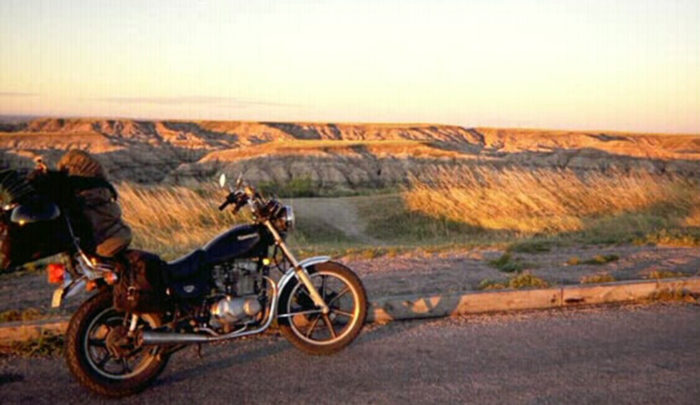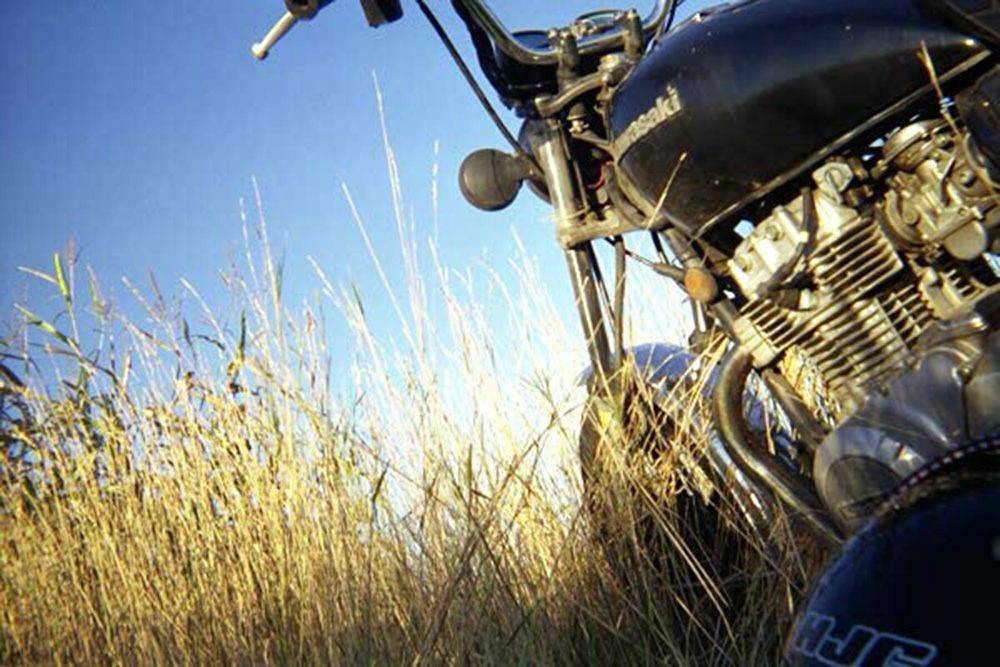This place looks nothing like the Moon, unless the Moon is made of blasted chunks of tar glued together by Dr. Seuss. When it was named that must have been the strangest place they could think of, but now we’re too familiar with the good old Moon, we’ve seen too many pictures and so must go farther out — this place could have been pulled down from dark Pluto or somewhere beyond the rim. The Craters of the Moon are 84 square miles of black madness.
There are signs of volcanism and heat in the earth all across southeastern Idaho. I stopped in the town of Soda Springs to see their “captive geyser,” which shoots 100 feet into the air every hour but comes out of a pipe stuck in the ground and is controlled by a timer; the heat and the pressure in the water, though, are natural. Then I passed a town with hot springs which I swung through just to make sure the springs were properly fenced off and controlled and there was a high enough admission being charged so I wouldn’t have to bother stopping- they were and there was. Just past Blackfoot I saw the first old lava beds along the road, instantly and startlingly recognizable as lava but pale with age as lichens, grasses and bushes coated, poked through and surrounded the broken pieces of flow. The lava beds are vast, stretching across the land and swallowing whole rivers: the Lost River flows into the lava and falls under it, disappearing from the face of the Earth for 120 miles until it resurfaces as a series of springs.
But at the Craters of the Moon the ground turns black. I passed through a wall of twisted black rock 20 feet high that rose up without warning like a goblin fortification. I didn’t believe it was natural — I thought it was rubble bulldozed into piles when they made the road, but the piles went on and on in a black sea of shattered debris. It was bulldozed thousands of years ago by flowing lava. The whole landscape looks like it just stopped smoking.
One expedition to the Craters of the Moon estimated that the volcanic activity that created the area occurred 150 years ago. That’s what any reasonable person would conclude; the lava looks brand-new, vivid, dark, and perfect, every ripple and fold looks fresh-cooled. There are some trees poking through, though, so 150 years seems just right to have allowed them some time to grow, but the most recent lava here is 2000 years old. In human terms that’s so very long ago it’s hard to believe, hard to imagine that the land has not bothered to recover in all this time, but in rock time the lava has just tumbled out of its dark bed in the earth and hasn’t even woken up yet. At North Crater time has been frozen stock-still and has not so much as ticked over in that 2000 years: the crater at first looks like a big bare black hill until you come around to where the side collapsed and burst outward from the weight of the lava within, and from there you can follow the arc of the flow around the hill and into the valley. The chunks of the crater wall were carried by the flow and now tower above the flat lava plain like monumental sculptures of forgotten mineral heroes. In the Devil’s Orchard are more such crater pieces.
Up close the lava does reveal colors: dark red-browns, orange-browns, chocolates and streaks of an oily blue sheen run through the brittle, airy rock. Whoever conceived of them in darkness had never actually seen colors, so understandably the best they could manage were these shades of black. Some of the pieces are as light as wood, pocked with bubbles, and make a high, glassy “chink” sound when dropped. Still trying to warm my hands from the cold ride, I read the signs and learn Hawaiian words to describe an Idaho landscape that looks like it fell from the stars. Pahoehoe (pa-hoy-hoy) is the smooth or ropey lava that was fluid until it stopped and cooled, while aa (ah-ah) is the lava of jagged broken chunks that looks like a fine-grain boulderfield but is really a kind of flow made as the crust cools, crumbles and is ground into pieces by its own motion while it is carried along by the still-molten lava beneath it. Much of the pahoehoe looks like burned dough, twisted, knotted, and billowing.
There are three spatter cones in a row like science fair volcanoes 50 feet high, formed by gurgling lava throwing globs of liquid rock up to form a rising ring around the opening. The middle one looks like a pile of skulls. There’s a path to the top from which I can look down its cold throat. Visible down inside the cone on the right is dirty snow, not from this year but left over from last winter.
Inferno Cone is a smooth cinder cone of fine particles like a giant rounded anthill. It looks like it’s dusted with tiny patches of snow which are actually small pale plants clinging to the gravel. The cone is deceptively massive and I can’t hear my motorcycle from the top, but I can see out across an ink-soaked landscape that’s like nothing I’ve ever seen.
Every time I go to the supermarket, any supermarket anywhere, I stare dumbly at the same magazine covers in the checkout line: Cosmopolitan, TV Guide, Enquirer, Weekly World News. Presumably so does everybody else who has to eat, and as easily as that another brace of junky, useless information is casually transmitted throughout the culture. Strangers a thousand miles apart could recognize this month’s Cosmopolitan model and her outfit equally well, while in the middle of the continent there’s a giant patch of night tattooed on the Earth that sits silent and unconsidered.

